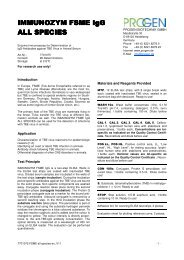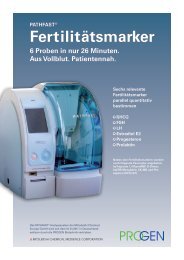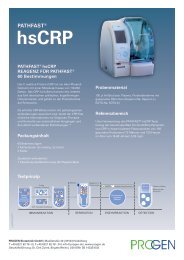Datasheet - PROGEN Biotechnik GmbH
Datasheet - PROGEN Biotechnik GmbH
Datasheet - PROGEN Biotechnik GmbH
Create successful ePaper yourself
Turn your PDF publications into a flip-book with our unique Google optimized e-Paper software.
<strong>PROGEN</strong> <strong>Biotechnik</strong> <strong>GmbH</strong> ⋅ Maaßstraße 30 ⋅ 69123 Heidelberg ⋅ Germany<br />
Tel.: +49 (0) 6221 8278-0 ⋅ Fax: +49 (0) 6221 8278-24 ⋅ Email: info@progen.de ⋅ Web: www.progen.de<br />
Mab to Adipophilin / ADRP / PLIN2<br />
N-terminus specific<br />
Clone Determination AP 125<br />
Category<br />
Immunoglobulin Class<br />
Purification / Form<br />
Immunogen<br />
Description/Specificity<br />
Tissue Immunolocalization<br />
Antigen recognized in species<br />
(tested so far)<br />
Reactivities on Cultured Cell<br />
Lines (tested so far)<br />
Mouse monoclonal<br />
IgG1<br />
Hybridoma culture supernatant<br />
Synthetic peptide (aa 5-27 from N-terminus of human adipophilin)<br />
Adipophilin / ADRP / PLIN2 is a ubiquitous component of lipid droplets. It has<br />
been found in milk fat globule membranes and on the surface of lipid droplets<br />
in various cultured cell lines (see e.g. Heid et al. 1998; for review see e.g.<br />
Targett-Adams et al.); inducible by etomoxir.<br />
Enhanced expression of Adipophilin / ADRP / PLIN2 is a useful marker for<br />
pathologies characterized by increased lipid droplet accumulation. Such<br />
diseases include atheroma, steatosis, obesity and certain cases of<br />
liposarcoma. It also seems to be a potent marker for atherosclerosis. ADRP<br />
can also be used to study virus entry via lipid droplets (see e.g. Hope et al. ,<br />
Samsa et al.).<br />
Polypeptide reacting: Adipophilin / ADRP / PLIN2, MW 48,100 (calculated<br />
from aa sequence data); apparent M r 52,000 (after SDS-PAGE); pI 6.72<br />
Adipophilin / PLIN2 is positively detected in the glandular cells of lactating<br />
mammary gland (ductal cells are negative), zona fasciculata of the adrenal<br />
gland, Sertoli cells of the testis, and in fat-accumulating hepatocytes of<br />
alcoholic cirrhotic fatty liver; adipocytes are negative.<br />
Also positively stained are lipid-storing CD 68-positive macrophages.<br />
Human, rat, dog; negative with bovine, mouse<br />
Caco, PLC, HaCat, SV80, RD 125, Huvec<br />
(human umbilical cord endothelia), RV, PC-12 (rat adrenal gland), MDCK;<br />
negative with glioma<br />
Application • Immunoblotting (Western blot)<br />
• Immunohistochemistry of frozen tissue (for staining protocols see<br />
ref. Ohsaki et al.)<br />
• Paraffin-embedded tissue after microwave treatment (for staining protocol<br />
see Straub et al. 2008)<br />
• Cytological material<br />
Working Dilution<br />
Storage At 2 - 8°C<br />
Volume<br />
Ready-to-use for immunohistochemistry<br />
5 mL (contains 0.09% sodium azide)<br />
Cat. No. 651102<br />
Page/Seite 1 of/von 2<br />
651102/DS-160514
<strong>PROGEN</strong> <strong>Biotechnik</strong> <strong>GmbH</strong> ⋅ Maaßstraße 30 ⋅ 69123 Heidelberg ⋅ Germany<br />
Tel.: +49 (0) 6221 8278-0 ⋅ Fax: +49 (0) 6221 8278-24 ⋅ Email: info@progen.de ⋅ Web: www.progen.de<br />
References<br />
Heid HW, Moll R, Schwetlick I, Rackwitz HR and Keenan TW. Adipophilin is a specific marker of lipid accumulation in diverse cell types<br />
and diseases. Cell Tissue Res 294, 309-321 (1998)<br />
Heid HW, Schnölzer M and TW Keenan. Adipocyte differentiation-related protein is secreted into milk as a constituent of milk lipid<br />
globule membrane. Biochem J 320, 1025-1030 (1996)<br />
Hope RG and McLauchlan J. Sequence motifs required for lipid droplet association and protein stability are unique to the hepatitis C<br />
virus core protein. J General Virology 81, 1913-1925 (2000)<br />
Ostermeyer AG, Paci JM, Zeng Y, Lublin DM, Munro S, Brown DA. Accumulation of Caveolin in the endoplasmic reticulum redirects<br />
the protein to lipid storage droplets. J Cell Biol 152, 1071-1078 (2001)<br />
Fujimoto T, Kogo H, Ishiguro K, Tauchi K, Nomura R. Caveolin-2 is targeted to lipid droplets, a new "Membrane Domain" in the cell. J<br />
Cell Biol 152, 1079-1085 (2001)<br />
Buechler C, Ritter M, Duong C Q, Orso E, Kapinsky M, Schmitz G. Adipophilin is a sensitive marker for lipid loading in human blood<br />
monocytes. Biochim Biophys Acta 1532, 97-104 (2001)<br />
Hope RG, Murphy DJ, McLauchlan J. The domains required to direct core proteins of hepatitis C virus and GB Virus-B to lipid droplets<br />
share common features with plant oleosin proteins. J Biol Chem 277, 4261-4270 (2002)<br />
Fukumoto S, Fujimoto T: deformation of lipid droplets in fixed samples. Histochem Cell Biol 118, 423-428 (2002)<br />
Targett-Adams P, Chambers D, Gledhill S, Hope RG, Coy JF, Girod A, McLauchlan J. Live cell analysis and targeting of the lipid<br />
droplet-binding ADRP protein. J Biol Chem 278, 15998-16007 (2003)<br />
Bulankina AV: TIP47 is recruited to lipid droplets and important for the organelle biogenesis and function. PhD Thesis University of<br />
Goettingen (2003)<br />
Opretzka, ME: Topographie und Dynamik von Perilipin und Adipophilin in Lipidtropfen. PhD Thesis, University of Muenster/Germany<br />
(2005)<br />
Eisenberg, M: Die Regulation der Adipophilin-Expression. . PhD Thesis, University of Muenster/Germany (2005)<br />
Robenek H, Lorkowski S, Schnoor M, Troyer D: Spatial integration of TIP47 and adipophilin in macrophage lipid bodies. J Biol Chem<br />
280, 5789-5794 (2005)<br />
Robenek H, Robenek MJ, Buers I, Lorkowski S, Hofnagel O, Troyer D, Severs NJ: Lipid droplets gain PAT family proteins by<br />
interaction with specialized plasma membrane domains. J Biol Chem 280, 26330-26338 (2005)<br />
Ohsaki Y, Maeda T, Fujimoto T: Fixation and permeabilization protocol is critical for the immunolabeling of lipid droplet proteins.<br />
Histochem Cell Biol 124, 445-452 (2005)<br />
Robenek H, Hofnagel O, Buers I, Robenek MJ, Troyer D, Severs NJ: Adipophilin-enriched domains in the ER membrane are sites of<br />
lipid droplet biogenesis. J Cell Science 119, 4215-4224 (2006)<br />
Larigauderie G, Cuaz-Pérolin C, Younes AB, Furman C, Lasselin C, Copin C, Jaye M, Fruchart J-C, Rouis M: Adipophilin increases<br />
triglyceride storage in human macrophages by stimulation of biosynthesis and inhibition of ß-oxidation. FEBS J 273, 3498-3510 (2006)<br />
Muthusamy K, Halbert G, Roberts F: Immunohistochemical staining for adipophilin, perilipin and TIP47 in ocular sebaceous gland<br />
carcinoma. J Clin Pathol 59, 1166-1170 (2006)<br />
Straub BK, Stoeffel P, Heid H, Zimbelmann R, Schirmacher P: Differential pattern of lipid droplet-associated proteins and de novo<br />
perilipin expression in hepatocyte steatogenesis. Hepatology 47, 1936-1946 (2008)<br />
Samsa MM, Mondotte JA, Iglesias NG, Assunçao-Miranda I, Barbosa-Lima G, Da Poian AT, Bozza PT, Gamarnik AV: Dengue virus<br />
capsid protein usurps lipid droplets for viral particle formation. PLOS Pathogens 5 (10) e1000632 (2009)<br />
Ostler DA, Prieto VG, Reed JA, Deavers MT, Lazar AJ, Ivan D: Adipophilin expression in sebaceous tumors and other cutaneous<br />
lesions with clear cell histology: an immunohistochemical study of 117 cases. Modern Pathology 23, 567-573 (2010)<br />
Straub BK, Herpel E, Singer S, Zimbelmann R, Breuhahn K, Macher-Goeppinger S, Warth A, Lehmann-Koch J, Longerich T, Heid H,<br />
Schirrmacher P: Lipid-droplet-associated PAT-proteins show frequent and differential expression in neoplastic steatogenesis. Modern<br />
Pathology 23, 480-492 (2010)<br />
Heid HW, Rickelt S, Zimbelmann R, Winter S, Schumacher H, Dörflinger Y (2013): Lipid droplets, perilipins and cytokeratins –<br />
unravelled liaisons in epithelial-derived cells (PLoS ONE 8(5): e63061. doi:10.1371/journal.pone.0063061)<br />
Heid H, Rickelt S, Zimbelmann R, Winter S, Schumacher H, Dörflinger Y, Kuhn C, Franke WW: On the formation of lipid droplets in<br />
human adipocytes: The organization of the perilipin-vimentin cortex. (2014: PloS ONE 9(2): e90386. doi:10.1371/journal.pone.0090386)<br />
Cat. No. 651102<br />
Page/Seite 2 of/von 2<br />
651102/DS-160514









